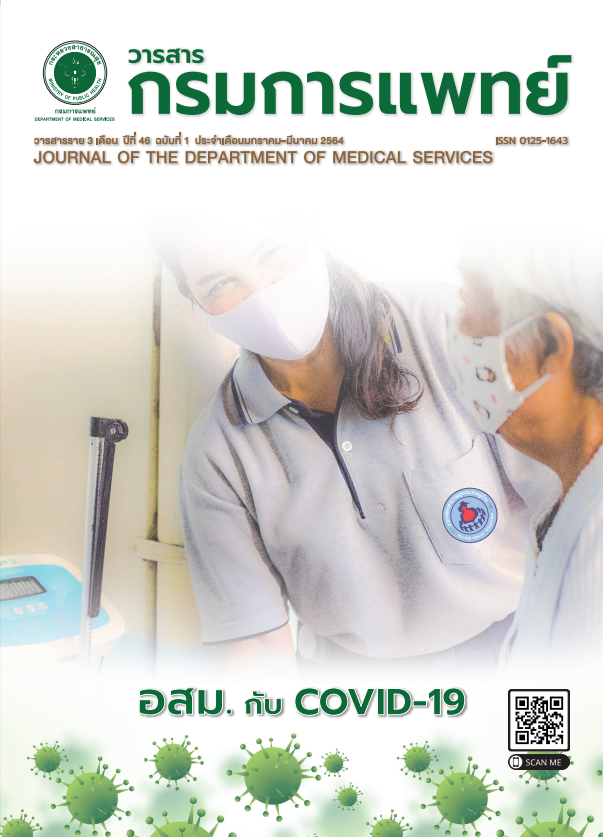ระบาดวิทยาอัตราชุกและประสิทธิภาพการเฝ้าระวังการติดเชื้อในโรงพยาบาลแผนกอายุรกรรม โรงพยาบาลนพรัตนราชธานี
คำสำคัญ:
อัตราชุก, ประสิทธิภาพการเฝ้าระวัง, การติดเชื้อในโรงพยาบาลบทคัดย่อ
ภูมิหลัง : การติดเชื้อในโรงพยาบาลมีความสัมพันธ์อย่างยิ่ง ต่อการเจ็บป่วยและการตาย ซึ่งการติดเชื้อในโรงพยาบาล สามารถ ป้องกันได้โดยการใช้ระบบการเฝ้าระวังที่รัดกุม อย่างไรก็ดี การ ศึกษาถึงสาเหตุ อัตราชุกของการติดเชื้อในโรงพยาบาล นั้นควร เป็นสิ่งแรกๆ ที่ควรทำการศึกษาเพื่อให้สามารถดำเนินการวางแผน การเฝ้าระวังการติดเชื้อในโรงพยาบาลได้อย่างมีประสิทธิภาพยิ่งขึ้นวัตถุประสงค์ : 1) เพื่อสำรวจอัตราชุกของการติดเชื้อในโรงพยาบาล แผนกอายุรกรรม โรงพยาบาลนพรัตนราชธานี 2) เพื่อประเมิน ประสิทธิภาพการเฝ้าระวังการติดเชื้อในโรงพยาบาล แผนกอายุรกรรม โรงพยาบาลนพรัตนราชธานีวิธีการ : การศึกษานี้ทำการสำรวจความ ชุก โดยการรวบรวมข้อมูลย้อนหลังระหว่างวันที่ 31 พฤษภาคม- 30 มิถุนายน 2561 ในแผนกอายุรกรรม จำนวน 8 หอผู้ป่วย สำรวจใน ผู้ป่วยที่รับไว้รักษาในโรงพยาบาล อยู่มากกว่า 2 วันปฏิทิน ดำเนินการ รวบรวมข้อมูลการติดเชื้อในโรงพยาบาลโดยพยาบาลควบคุมการ ติดเชื้อในโรงพยาบาล (ICN) และพยาบาลควบคุมการติดเชื้อ ประจำหอผู้ป่วย (ICWN) ใช้แบบบันทึกการเฝ้าระวังการติดเชื้อใน โรงพยาบาลนพรัตนราชธานี (surveillance form1) บันทึกข้อมูล ลงโปรแกรมสำเร็จรูป วิเคราะห์ข้อมูลโดยใช้สถิติเชิงพรรณนาผล : ผลการศึกษาพบอัตราความชุกของโรคติดเชื้อคิดเป็นร้อยละ 5.3 (49/919) จากผู้ป่วยที่สำรวจ 919 ราย พบหอผู้ป่วยที่อัตรา ความชุกสูงสุด คือ หอผู้ป่วยกึ่งวิกฤตหญิงร้อยละ 10.3 รองลง มาคือ หอผู้ป่วยวิกฤตอายุรกรรมร้อยละ 9.3 และพิเศษเดี่ยว อายุรกรรมร้อยละ 9.1 ตามลำดับ ระบบที่พบมีการติดเชื้อสูงสุด คือ ปอดอักเสบร้อยละ 30.6 รองลงมาคือ การติดเชื้อระบบทางเดิน ปัสสาวะที่สัมพันธ์กับการใส่สายสวนปัสสาวะร้อยละ 26.5 และ การติดเชื้อระบบทางเดินปัสสาวะร้อยละ 16.3 ประสิทธิภาพการ เฝ้าระวังร้อยละ 85.7สรุป : ระบาดวิทยาการติดเชื้อในโรงพยาบาล แผนกอายุรกรรม โรงพยาบาลนพรัตนราชธานี จำแนกตามจุลชีพก่อ โรคคือ เกิดภาวะปอดอักเสบจาก A.baumannii MDR ร้อยละ 25, E.coli และ K.pneumoniae ร้อยละ 16.7 การติดเชื้อระบบทาง เดินปัสสาวะที่สัมพันธ์กับการใส่สายสวนปัสสาวะจาก E.faecalis, C.tropicalis ร้อยละ 20 และการติดเชื้อระบบทางเดินปัสสาวะ จาก E.faecium, E.coli ร้อยละ 28.6 อัตราความชุกการติดเชื้อใน โรงพยาบาล คิดเป็นร้อยละ 5.3 ส่วนประสิทธิภาพการเฝ้าระวัง คิด เป็นร้อยละ 85.7 ซึ่งสูงสำหรับการป้องกันและควบคุมการติดเชื้อ ในโรงพยาบาล
เอกสารอ้างอิง
Russo PL, Stewardson AJ, Cheng AC, Bucknall T, Mitchell BG.The prevalence of healthcare associated infections among adult inpatients at nineteen large Australian acute-care public hospitals: a point prevalence survey.Antimicrob Resist Infect Control 2019;8:114.
Petersen MH, Holm MO, Pedersen SS, Lassen AT, Pedersen C.Incidence and prevalence of hospital-acquired infections in a cohort of patients admitted to medical department. Dan Med Bull 2010;57:A4210.
Aumprasert T. Prevalence of Hospital Acquired Infections Survey at Queen Sirikit National Institute of Child Health 2015. Journal of the Department of Medical Services 2017;42:6.
Infection Control Committee, Nopparat Rajathanee Hospital.Infection surveillance report in Hospital; 2004.
Unahalekhaka A. Epidemiology and Evidence-Based Practice Guideline in Prevention of Hospital-Associated Infection. ChiangMai: Mingmuangnavarat Company LTD; 2013 (in Thai).
Unahalekhaka A. Prevention of Nosocomial Infection : Principles and Guidelines; 2012.
Unahalekhaka A. Nosocomial Infection Surveillance; 1997.
Labi AK, Obeng-Nkrumah N, Owusu E, Bjerrum S, Bediako-Bowan A, Sunkwa-Mills G, et al. Multi-centre point--prevalence survey of hospital-acquired infections in Ghana. J Hosp Infect 2019;101:60-8.
Wu YL, Yang XY, Pan MS, Li RJ, Hu XQ, Zhang JJ, et al. An 8-year point-prevalence surveillance of healthcare-associated infections and antimicrobial use in a tertiary care teaching hospital in China. Epidemiol Infect 2018;147: 1-6.
Van Mourik MSM, Perencevich EN, Gastmeier P, Bonten MJM.Designing Surveillance of Healthcare-Associated Infections in the Era of Automation and Reporting Mandates. Clin Infect Dis 2018;66:970-6.
ดาวน์โหลด
เผยแพร่แล้ว
รูปแบบการอ้างอิง
ฉบับ
ประเภทบทความ
สัญญาอนุญาต

อนุญาตภายใต้เงื่อนไข Creative Commons Attribution-NonCommercial-NoDerivatives 4.0 International License.
บทความที่ได้รับการตีพิมพ์เป็นลิขสิทธิ์ของกรมการแพทย์ กระทรวงสาธารณสุข
ข้อความและข้อคิดเห็นต่างๆ เป็นของผู้เขียนบทความ ไม่ใช่ความเห็นของกองบรรณาธิการหรือของวารสารกรมการแพทย์



